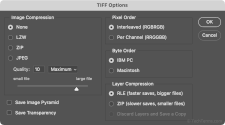TIFF
Stands for "Tagged Image File Format."
TIFF is an image file format for storing raster graphics. It is a versatile format that supports advanced features like layers, transparency, and multi-image files, although not all image programs support every feature. TIFF files can be high quality but are often much larger than other image types.
The TIFF format uses tags to store metadata for the image or images a file contains. These tags give the TIFF format its versatility — tags in a file's header define the image size, color depth, compression settings, and other information about each image in the file. Since TIFF files may contain multiple images, this allows each image in a file to have its own properties separate from the rest. TIFF files may also include private tags for special-purpose data, like GPS coordinates for high-resolution GIS imagery.
Since the TIFF format has been in use since the 1980s, it's one of the most well-supported and widely-used image formats. It is a standard format used in the publishing, photography, and graphic design industries for storing and sharing high-quality images. Long-term image archival often uses TIFF files because the built-in lossless compression minimizes file size while perfectly preserving image data.
TIFF Extensions
Not every program that can open a TIFF file supports every feature. All programs that open and edit TIFF files must include a basic set of features called Baseline TIFF. These features include 1- to 24-bit color for grayscale, indexed color, or full RGB. They also include multiple subfiles within a single TIFF file and basic lossless compression.
Optional TIFF Extensions add more features. These include additional color spaces like CMYK, YCbCr, and Lab. Extensions also support more compression methods like lossless LZW and lossy JPEG, and an alpha channel to add transparency to an image. TIFF files saved in one program might not display correctly in another program that supports fewer features.
NOTE: TIFF files may use both the .TIF and .TIFF file extensions.
 Test Your Knowledge
Test Your Knowledge